Hi guys in this article we try to learn the topic Mechanical Jacks we see in detail information about jacks definition of mechanical jacks, types of jacks so without wasting of time lets discuss further information,
Mechanical Jacks
Contents:
a) Mechanical Jacks
b) Types of mechanical jacks
c) What are mechanical jacks used for?
d) Advantages of Mechanical Jacks
Definition of Mechanical Jacks
A mechanical jack is a device used to lift heavy objects, such as a car or truck, using mechanical force. It typically consists of a vertical shaft with a screw thread, which is turned using a handle or crank to lift the object. The screw thread is attached to a lifting mechanism, which can be either a flat plate or a saddle-shaped mechanism designed to cradle the object being lifted.
Mechanical jacks come in various types and sizes, ranging from small ones that can lift a few hundred pounds to larger ones capable of lifting several tons. They are commonly used in automotive repair and maintenance, as well as in industrial settings for moving heavy equipment or machinery.
One advantage of mechanical jacks is that they do not require a power source or hydraulic fluid, making them more portable and easier to use in remote locations. However, they do require more physical effort to operate than hydraulic jacks or other powered lifting devices. Additionally, care must be taken when using a mechanical jack to ensure that the weight being lifted is properly supported and that the jack is not overloaded, as this can lead to dangerous accidents.
Types of mechanical jacks
There are several types of mechanical jacks available let's see,
a) Screw jack: This type of jack is operated by turning a screw thread, which raises or lowers the lifting mechanism. It is often used in industrial applications, such as moving heavy machinery.
b) Rack and pinion jack: This type of jack uses a gear system to raise or lower the lifting mechanism. It is commonly used in automotive repair and maintenance, as well as for lifting heavy loads in warehouses and factories.
c) Hydraulic jack: While technically a type of powered lifting device, hydraulic jacks still operate on mechanical principles. They use hydraulic fluid to generate pressure and lift heavy objects. They are used for automotive and industrial purpose.
d) Scissor jack: This type of jack consists of a collapsible frame and a threaded screw mechanism. When the screw is turned, the frame expands, raising the object being lifted. Scissor jacks are commonly used for lifting vehicles, such as cars and trailers.
e) Bottle jack: This type of jack consists of a cylindrical body with a hydraulic piston inside. When pressure is applied to the piston, it raises the lifting mechanism. Bottle jacks are commonly used in automotive and industrial settings.
f) Toe jack: This type of jack is designed to lift heavy objects that have a low profile, such as machinery or equipment. It uses a hydraulic mechanism to lift the object from the bottom, rather than the top.
What are mechanical jacks used for?
Mechanical jacks are often used to lift heavy objects such as vehicles or to provide support for structures during construction or repairs. They work by using a screw mechanism to translate rotational force into linear force, allowing the jack to raise or lower a load.
a) Automotive maintenance: Mechanical jacks are commonly used to lift cars or other vehicles to change tires, perform maintenance or repairs, or inspect the undercarriage.
b) Industrial applications: Mechanical jacks can be used to lift heavy machinery or equipment for maintenance, repairs, or installation.
c) Construction: Mechanical jacks can be used to support structures during construction or repair work, such as when replacing or reinforcing foundation supports.
d) Emergency situations: Mechanical jacks can be used in emergency situations, such as lifting a car or truck that has become stuck or overturned, or to prop up a collapsed structure during rescue operations.
Overall, mechanical jacks provide a convenient and effective
means of lifting or supporting heavy loads in a variety of settings.
These are just a few examples of the types of mechanical jacks available. The type of jack used will depend on the application and the weight of the object being lifted.
Advantages of Mechanical Jacks
Jacks offer several advantages over other methods let's see,
1) Portability: Jacks are typically compact and lightweight, making them easy to transport and use in a variety of settings.
2) Versatility: There are many different types of jacks available, each designed to suit different applications and load capacities.
3) Cost-effective: Compared to other methods of lifting heavy loads, such as cranes or forklifts, jacks are generally much more affordable.
4) Easy to use: Most jacks are simple to operate, with minimal training required to use them safely and effectively.
5) Precise positioning: Because jacks use a screw mechanism to raise or lower loads, they allow for precise positioning, making them useful for tasks that require careful alignment or adjustment.
6) Safety: Jacks are designed to be stable and secure during
use, minimizing the risk of accidents or injuries.
So in this article we learned the topic Mechanical Jacks hope you understand well.
If you any query regarding article comment below. 🙏Thanks for reading.



.jpg)



